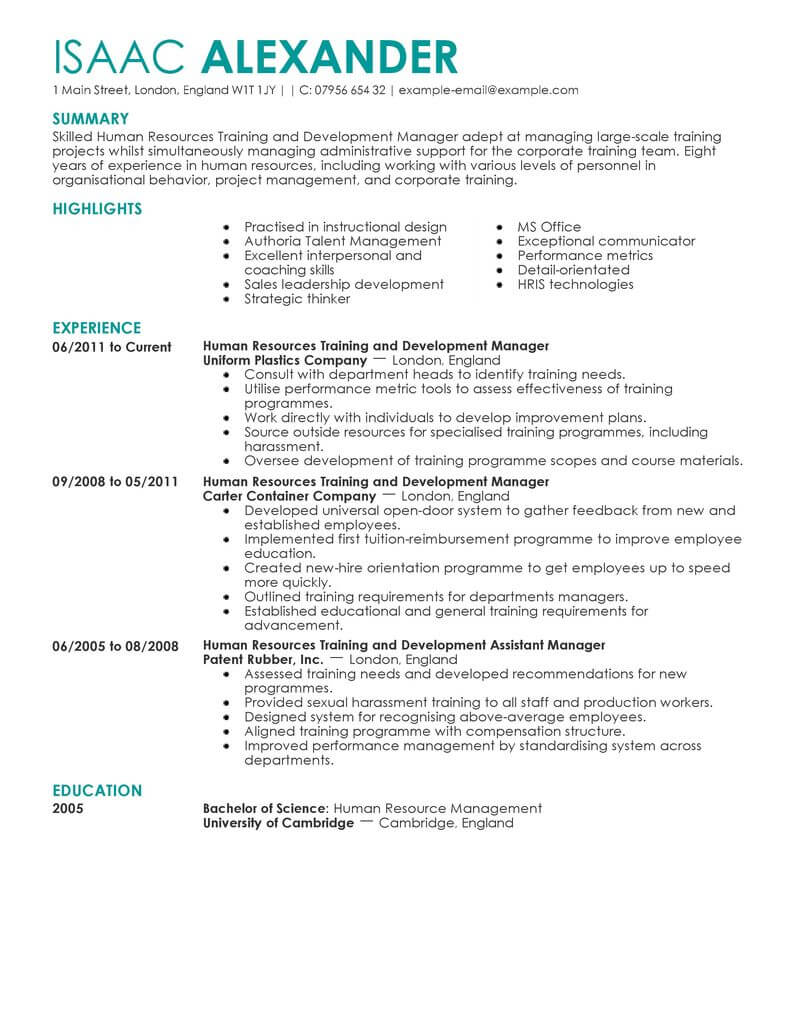Best Training And Development Resume Example
Published: Monday 1st of January 2018; Words Count: 800
Training and development is a functional area that is being transformed by new technologies. Demonstrating that youâre intimately familiar with these in your resume and proving that you have tapped them to deliver successful training programs helps you rise above other applicants. Additionally, use of social media and collaborative training tools is of particular interest to many employers. And when delineating your experiences on the resume, call out instances where those initiatives have translated into lower costs, an area of top concern for many organizations. Bachelorâs degrees are a normal requirement for training and development professionals, and some jobs require masterâs degrees and certifications; ensure these are easy to find in your resume. See our training and development resume example for more ideas.
Training And Development Advice
As a training and development professional, youâre responsible for helping prepare new employees to succeed in the workplace. To succeed in a training and development role, you should have a quality resume that outlines your experience and qualifications. What should you resume look like? These resume examples give you a good idea. Use our resume examples as a guide in crafting your resume, and apply for jobs with added confidence.

Resume Tips for Training And Development
Research is necessary to find the right jobs as a training and development. Additionally, any job hunt requires a great deal of time and effort. Here are some tips to make your search more productive.
1. Read the mission statement first. Resist the urge to apply the minute you find the perfect position. Instead, take some time to learn about the company and its culture to be sure itâs even a place you want to work.
2. Network offline. Itâs easy to hide behind a computer, but face-to-face networking is the best way to get noticed. Reach out to people in your field, or try to get in contact with an internal recruiter.
3. Volunteer your time or skills. This may seem counterproductive, but itâs simply another form of networking. If youâve got the extra time, itâs a great way to prove your abilities and personality while also doing some good in the world.
4. Develop a list of interview questions. Study the job description and try to formulate possible questions regarding the duties and your transferable skills. Then, practice your answers out loud in front of someone. Youâve got to be comfortable thinking on the spot.
5. Document. Create a list with the details of each job application, including the date of submission, the resume you used and a copy of the job description. This will help you track your progress and quickly recall information if you receive a phone call.

Training And Development Job Seeking Tips
Before sending your resume out for jobs as a training and development, make sure itâs clean, professional and free from error. Here are some key tips to keep in mind.
1. Donât exceed two pages. This is a general rule that applies to most jobseekers. Unless youâre a published researcher, you probably donât need a lengthy CV. Most screeners have little interest in reading past one or two pages.
2. Use accomplishment-focused verbs. Collaborated, directed, executed, exceeded âthese are all words that describe how you did something rather than simply what you did.
3. Donât leave off months. If you do, employers will wonder whether you mean December or January. Thatâs a big difference.
4. Look for hidden jobs. This usually requires some networking skills. Keep up with job boards, but branch out to professional associations and company vendors. The idea is to find out about an opportunity before itâs publicly advertised.
5. Look to recession-proof industries. If youâre having trouble finding a suitable role, hone in on technology, government, education and healthcare. These industries will operate regardless of the current economic condition.






